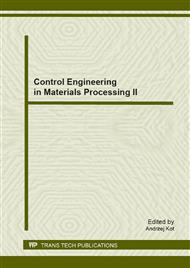[1]
Z. Mendera, L. Szojda and G. Wandzik: (Polish Scientific Publishers PWN 2012). (in Polish)
Google Scholar
[2]
J. Dobson, B.A. Carreras, V.E. Lynch and D.E. Newman: Chaos Vol. 17 (2007).
Google Scholar
[3]
B.A. Carreras, V.E. Lynch, D.E. Newman and I. Dobson: System Sciences (2003).
Google Scholar
[4]
T. Paczkowska and W. Paczkowski, in: XXIV Scientific and Technical Conference "Construction failures", Szczecin-Miedzyzdroje, 26-29 May (2009).
Google Scholar
[5]
W. Kępa: (Lubuskie Society for Energy Development, Gorzow Wielkopolski 2009). (in Polish)
Google Scholar
[6]
KGHM Polska Miedź S.A. VIII Scientific and Technical Conference "Recipients on the energy market."
Google Scholar
[7]
M. Kornatka: Energy Market No. 1 (2010).
Google Scholar
[8]
PN-EN-10025:1990 Hot rolled products of non-alloy structural steels. Technical delivery conditions.
DOI: 10.3403/30239477
Google Scholar
[9]
R. Newnham: Properties of materials. Anisotropy, symmetry, structure (Oxford University Press 2005).
Google Scholar
[10]
P. Ruuskanen: Magnetomechanical effect in polycrystalline iron and nickel during cycling stressing. Doctoral thesis (Tampere University of Technology 1987).
Google Scholar
[11]
L. Fuentes: Textures and Microstructures Vol. 30 (1998), p.167.
Google Scholar
[12]
D.C. Jiles: J. Phys. D: Appl. Phys. Vol. 28 (1995) p.1537.
Google Scholar
[13]
T. Erber, S.A. Guralnick, R.D. Desai and W. Kwok: J. Phys. D: Appl. Phys. Vol. 30 (1977) p.2818.
Google Scholar
[14]
S.A. Guralnick, S. Bao and T. Erber: J. Phys. D: Appl. Phys. Vol. 41 (2008) p.11.
Google Scholar
[15]
M. Adamo: Non-destructive surface and sub-surface material analysis using scanning SQUID magnetic microscope. PhD Thesis (Universita' Degli Studi di Napoli Federico II 2008).
Google Scholar
[16]
L. Tae-Kyu, J.W. Jr. Morris, L. Seungkyun and J. Clarke: Review of Progress in Quantitative Nondestructive Evaluation Vol. 25 p.1378.
Google Scholar
[17]
C. Bonavolontà, M. Valentino, M. Adamo and E. Sarnelli: Meas. Sci. Technol. Vol. 18 Iss. 7 (2007) p.2116.
Google Scholar
[18]
S. Kocańda: (PWN Warsaw 1957). (in Polish)
Google Scholar
[19]
M. Witoś: Increasing the durability of turbine engine components through active diagnostics and control (Research Works of AFIT 2011, Issue 29).
Google Scholar
[20]
K.A. Fonteyn: Energy-based magneto-mechanical model for electrical steel sheets. Doctoral Dissertation (Aalto University 2010).
Google Scholar
[21]
M.J. Dapino: Nonlinear and hysteretic magnetomechanical model for magnetostrictive transducers. PhD Dissertation (Iowa State University 1999).
DOI: 10.31274/rtd-180813-13922
Google Scholar
[22]
L. Rayleigh: Phil. Mag. Vol. 23 (1887) p.225.
Google Scholar
[23]
J. Hopkinson, in: Proceedings of the Royal Society (1890).
Google Scholar
[24]
C.M. Smith and G.W. Jr. Sherman: Steel. Phys. Rev. Vol. 4 (1914) p.267.
Google Scholar
[25]
C.W. Waggoner: Phys. Rev. (Series I) Vol. 35 (1912) p.58.
Google Scholar
[26]
Ch. W. Burrows: Correlation of the magnetic and mechanical properties of steel (Scientific Papers of the Bureau of Standards No 272 1916).
Google Scholar
[27]
International Critical Tables of Numerical Data, Physics, Chemistry and Technology Vol. VI, National Research Council, printed by McGraw-Hils Book Company Inc., New York/London, (1929).
Google Scholar
[28]
R.M. Bozorth and H.J. Williams: Rev. Mod. Phys. Vol. 17 No 1 (1945) p.72.
Google Scholar
[29]
D.J. Craik and R.J. Fairholme: Journal de Physique sup. 2–3, T. 32 (1971) p. C1.
Google Scholar
[30]
M. Robertson: Acta metall. mater. Vol. 42 No. 3 (1994) p.661.
Google Scholar
[31]
M. Witoś and M. Wiśnioch: (Warsaw 2010 unpublished, commissioned by WSiMR PW). (in Polish)
Google Scholar
[32]
E.F. Gallaudet: Relation between length, elasticity and magnetization of iron and nickel wires. PhD Dissertation (Johns Hopkins University 1896).
Google Scholar
[33]
H. Nagaoka and K. Honda: Researches on Magnetostriction. The Journal of the College of Science, Imperial University of Tokyo 1898–1925, Section 353.
Google Scholar
[34]
The Journal of the College of Science, Imperial University of Tokyo 1901–1908, Vol. XVI, Article 8–10, 12–14.
Google Scholar
[35]
J.R. Jr. Hobbie: Physical Review Vol. XIX No. 5 (1922).
Google Scholar
[36]
E.W. Lee: Rep. Prog. Phys. Vol. 18 (1955) p.184.
Google Scholar
[37]
T. Yamasaki, S. Yamamoto and M. Hirao: NDT&E International Vol. 29 No. 5 (1996) p.263.
Google Scholar
[38]
R.L. Sandford: Effect of stress on the magnetic properties of steel wire (Scientific Papers of the Bureau of Standards No. 272 1916).
Google Scholar
[39]
319-1990 - IEEE Standard on Magnetostrictive Materials: Piezomagnetic Nomenclature.
Google Scholar
[40]
D.L. Atherton, L.W. Coathup, D.C. Jiles, L. Longo, C. Welbourn and A. Teitsma: IEEE Transactions on Magnetics Vol. MAG-19, No. 4 (1983) p.1564.
DOI: 10.1109/tmag.1983.1062576
Google Scholar
[41]
J. Pearson and P.T. Squire: Journal of Applied Physics Vol. 83 No 11 (1998) p.6572.
Google Scholar
[42]
S.K. Burke and M.E. Ibrahim: Electrical and Magnetic Properties of D6ac Steel. DSTO-TN-0757, Defence Science and Technology Organisation (2007).
Google Scholar
[43]
M.S. Blanter, I.S. Golovin, H. Neuhäuser and H.R. Sinning: Internal Friction in Metallic Materials. A Handbook (Springer-Verlag Berlin 2007).
DOI: 10.1007/978-3-540-68758-0
Google Scholar
[44]
B.M. Jankowski: (PWN Warsaw 1958). (in Polish)
Google Scholar
[45]
M. Kuroda, S. Yamanaka, K. Yamada and Y. Isobe: Journal of Alloys and Compounds Vol. 314 (2001) p.232.
Google Scholar
[46]
J. Polak, M. Petrenec and S. Degallaix: Scripta Materialia Vol. 47 (2002) p.731.
Google Scholar
[47]
M. Roskosz, A. Rusin and J. Kotowicz: Journal of Achievements in Materials and Manufacturing Engineering Vol. 43/1 (2010) p.362.
Google Scholar
[48]
S. Gontarz and S. Radkowski: IEEE Transactions on Magnetics Vol. 48 Iss. 3 (2012) p.1143.
Google Scholar
[49]
Ordinance of the Minister of Environment of 30 October 2003 on acceptable levels of electromagnetic fields in the environment and on methods of verifying the fulfillment of these levels. JoL 2003 No. 192, item 1883.
Google Scholar
[50]
V.T. Vlasov and A.A. Dubov: Physical base of the metal magnetic memory method (ZAO "Tisso" Publishing House Moscow 2004).
Google Scholar
[51]
A.A. Dubow and S.M. Kołokolnikow: (RESURS Warszawa 2004). (in Polish)
Google Scholar
[52]
M. Witoś: Key Engineering Materials Vol. 518 (2012) p.384.
Google Scholar


